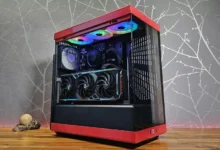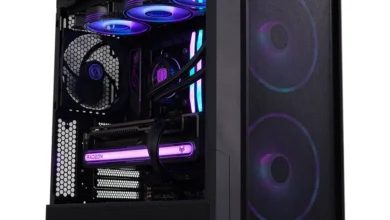Budget Gaming PC with Upgrade Options

Building a gaming PC doesn’t have to break the bank. A budget gaming PC with upgrade options can deliver a stellar gaming experience while allowing room for improvement as your needs grow. In this article, we will guide you through the essential components of a budget gaming PC, provide tips on how to optimize performance, and explore upgrade paths to ensure your PC can handle future gaming titles.
Why Choose a Budget Gaming PC?
When building a budget gaming PC with upgrade options, the goal is to balance cost and performance. Modern games can be demanding, but it is entirely possible to assemble a gaming rig that can play your favorite titles at 1080p or even 1440p without spending thousands of dollars. The key is to select components that offer the best value, prioritize performance, and leave room for future upgrades.
Components of a Budget Gaming PC with Upgrade Options
To get started with your budget gaming PC with upgrade options, you’ll need to carefully select the main components: CPU, GPU, RAM, storage, motherboard, power supply, and case. Below, we will explore each component and suggest options that strike a balance between affordability and future-proofing.
| Component | Budget Option | Upgrade Path |
|---|---|---|
| CPU | AMD Ryzen 5 5600X | AMD Ryzen 7 5800X, Intel Core i7-12700K |
| GPU | NVIDIA GTX 1660 Super | NVIDIA RTX 3060 Ti, RTX 4070 |
| RAM | 16GB (2x8GB) DDR4-3200 | 32GB DDR4-3600 or DDR5 for more power |
| Storage | 500GB NVMe SSD | 1TB NVMe SSD or additional HDD |
| Motherboard | MSI B450 TOMAHAWK MAX | B550 or Z590 for better future support |
| Power Supply | 600W 80+ Bronze | 750W 80+ Gold for higher power needs |
| Case | NZXT H510 | Phanteks P400A or larger airflow cases |
1. CPU (Central Processing Unit)
The CPU is the brain of your budget gaming PC with upgrade options. A good processor is essential for running games smoothly. For budget builds, the AMD Ryzen 5 5600X offers incredible value with six cores and twelve threads, ideal for gaming and multitasking. However, if you want more power for future upgrades or multitasking, you could upgrade to a higher-tier processor, like the Ryzen 7 5800X or an Intel Core i7 model.
Upgrade Path:
You could swap out the Ryzen 5 5600X for the Ryzen 7 5800X or Intel Core i7-12700K as your budget allows. These CPUs offer more cores and threads, which will be beneficial for gaming at higher settings or using the PC for other demanding tasks like streaming or video editing.
2. GPU (Graphics Processing Unit)
The GPU is arguably the most important component for gaming. With a budget gaming PC with upgrade options, the NVIDIA GTX 1660 Super offers excellent performance for 1080p gaming. It’s a great choice for gamers who want solid performance without paying the premium for newer RTX cards. If you’re planning on gaming at higher resolutions or aiming for ray tracing, you can upgrade to something like the RTX 3060 Ti or RTX 4070 for a massive boost in graphical power.
Upgrade Path:
As game titles become more demanding and you move into higher resolutions or embrace ray tracing, upgrading to a more powerful GPU like the RTX 3060 Ti or the RTX 4070 will ensure your PC stays capable for years.
3. RAM (Random Access Memory)
While 16GB of DDR4 RAM is more than enough for gaming, if you plan to stream, edit videos, or do other memory-intensive tasks, you might want to upgrade to 32GB of RAM. The budget gaming PC with upgrade options should initially use 16GB of DDR4-3200 memory. However, for high-end multitasking or future-proofing, DDR4-3600 or DDR5 RAM will give you a performance boost.
Upgrade Path:
Upgrading to 32GB of DDR4-3600 or DDR5 will make your PC more future-proof and better suited to gaming, content creation, and other intensive tasks.
4. Storage (SSD & HDD)
For your budget gaming PC with upgrade options, a 500GB NVMe SSD is the best balance of speed and capacity for gaming. It will significantly reduce loading times and give you ample space for your most-played games. However, as your game library grows, it’s advisable to add additional storage. A 1TB NVMe SSD or a traditional 1TB HDD can be added later to increase your storage capacity.
Upgrade Path:
Once your storage needs increase, adding a second SSD or an HDD for additional storage is a simple upgrade. NVMe SSDs offer faster load times, while HDDs provide larger storage space at a lower cost.
5. Motherboard
A motherboard such as the MSI B450 TOMAHAWK MAX is a reliable, cost-effective choice for a budget gaming PC with upgrade options. It supports most Ryzen processors and offers decent expandability. However, if you plan to upgrade your CPU in the future or need faster PCIe lanes for future GPUs, you should opt for a B550 or Z590 motherboard.
Upgrade Path:
A motherboard upgrade to a B550 or Z590 will open up additional features like PCIe 4.0 support, which can be beneficial for future GPU and SSD upgrades.
6. Power Supply (PSU)
A 600W power supply is sufficient for a budget build, but if you plan to upgrade to higher-end components, especially a power-hungry GPU, consider investing in a 750W PSU with 80+ Gold certification. This ensures that your budget gaming PC with upgrade options can handle future expansions without issues.
Upgrade Path:
As you add higher-performance components like more powerful GPUs or multiple storage devices, upgrading to a 750W or 850W power supply will ensure stability and reliability.

7. Case
Your PC case should provide good airflow and be compatible with your components. The NZXT H510 is a popular choice for budget gaming PCs, offering a sleek design and decent airflow. However, if you plan on adding more fans or a larger GPU, upgrading to a case with better airflow, such as the Phanteks P400A, will keep your system cool.
Upgrade Path:
Switching to a case with better airflow or more space, like the Phanteks P400A or a larger mid-tower, can make your system run cooler, especially as you upgrade other components.
FAQs about Budget Gaming PCs with Upgrade Options
1. How much should I spend on a budget gaming PC with upgrade options?
For a budget gaming PC, you can expect to spend around $600 to $900 for a solid base build that includes a decent CPU, GPU, 16GB of RAM, and storage. The cost will vary depending on the upgrades you choose.
2. Can I upgrade my gaming PC over time?
Yes! The beauty of a budget gaming PC with upgrade options is that you can easily swap out individual components as your needs evolve. Start with a budget-friendly setup and upgrade your GPU, CPU, RAM, and storage as your gaming needs grow.
3. Is it better to buy pre-built or build a budget gaming PC?
Building your own PC usually offers better value for money and allows for greater customization. Pre-built systems may have a slight convenience factor but often come at a premium.
4. What games can I play on a budget gaming PC?
With a budget gaming PC, you can comfortably play popular titles like Fortnite, Call of Duty Warzone, Apex Legends, and even newer games like Cyberpunk 2077 at 1080p with medium to high settings.
5. How can I improve my budget gaming PC without upgrading the GPU?
You can enhance performance by overclocking your CPU, upgrading to faster RAM, or adding more storage. However, for the most significant performance boost, the GPU is usually the best place to focus your upgrades.
Conclusion
Building a budget gaming PC with upgrade options is a smart approach for gamers who want performance today but don’t want to spend a fortune. By choosing the right components, you can create a gaming system that delivers smooth gameplay now while offering plenty of opportunities for upgrades down the road. Whether you’re just starting or looking to future-proof your setup, a budget gaming PC with upgrade options ensures that you can enjoy the latest games without sacrificing too much money. Happy building!





